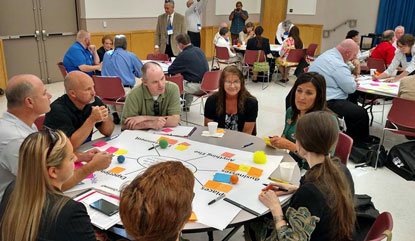If you’ve been a Brainzooming reader for any length of time, you know we’re huge proponents of collaborative strategic planning. Collaborative planning implies a process that goes beyond the board room to include individuals throughout the organization in meaningful ways to provide insights and input to shape organizational strategy.
Admittedly, collaborative planning processes aren't all that common.
In fact, it may be relatively rare.
Because of that rarity, we run into potential clients with serious apprehensions about opening the door wide to have employees throughout the organization share strategic ideas. That leads to a variety of misperceptions.
5 Things Collaborative Strategic Planning Isn't
Let’s try to clear up at least five of those misperceptions about collaborative planning.
Collaborative strategic planning isn't:
1. Unplanned
Instead of just inviting people and seeing what happens, we carefully identify and vet potential participants in collaborative strategy planning. This step ensures diverse perspectives and a process that allows them to participate successfully.
2. A democracy
A large group really makes collaborative strategy planning work. We ask them to provide ideas, input, and even express preferences and recommendations. While that input is vital, it isn’t the final say. The business leader still owns the decision making for what makes it into the final plan.
3. A free for all
We design collaborative strategy planning for each client with a clear understanding of the overall goal. While the individual steps may seem to go in varied and unexpected directions, they're all pointing toward the end result of a highly-actionable strategic plan.
4. The same for all participants
Individual participants take on different roles within collaborative strategy planning. They may work on different strategic thinking exercises and questions based on their perspectives and areas of expertise. The cumulative input provides a richer and more robust basis to align and coordinate the organization’s activities even though everyone didn’t participate in exactly the same ways.
5. More time consuming than less collaborative planning
Including additional participants allows for more efficient and concurrent input. Additionally, our design process takes into account what will make collaborative strategy planning participants most efficient and effective. The net of these two approaches is that our client engagements are months shorter than typical strategic planning processes.
Want to learn more about collaborative strategic planning benefits?
Download our Results!!! eBook and contact us (816-509-5320 or info@brainzooming.com) to discuss how a collaborative planning process can boost your organization’s strategy and results for 2017! - Mike Brown
10 Keys to Engaging Employees to Improve Strategic Results
FREE Download: "Results!!! Creating Strategic Impact"
Leaders need high-impact ways to develop employees that can provide input into strategic planning and then turn it into results. This Brainzooming mini-book, "Results - Creating Strategic Impact" unveils ten proven lessons leaders can use to boost collaboration, meaningful strategic conversations, and results.
Download this free, action-focused mini-book to:
- Learn smart ways to separate strategic opportunities from the daily noise of business
- Increase focus for your team with productive strategy questions everyone can use
- Actively engage stakeholders in strategy AND implementation success






